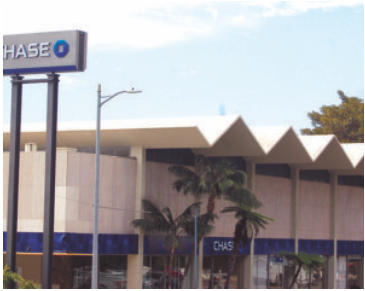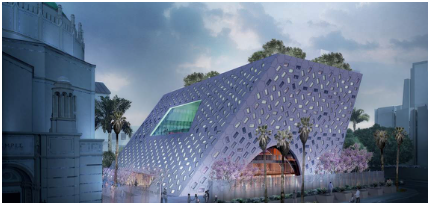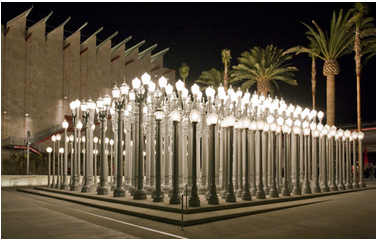CommentsDEEGAN ON LA-The wheels are grinding slowly on Frank Gehry’s 8150 Sunset Boulevard project as he moves forward to create his vision for the eastern gateway to West Hollywood’s Sunset Strip at Sunset and Crescent Heights.
This will require twin killings: first, the obliteration of a historic Hollywood site (what was the Garden of Allah – PHOTO ABOVE) that is mesmerizing even from just reading the commemorative plaque on a small traffic island, and second, a historic structure (Lytton Savings Bank) that despite efforts of preservationists, is inching closer to a date with dynamite.
It has been a contentious project from the beginning, riddled with community protests, appeals for historic preservation, and lawsuits but -- adapting from Henry Wadsworth Longfellow -- though the mills of Frank Gehry grind slowly…they grind exceeding small; though with patience he stands waiting, with exactness grinds he all.
And Gehry is getting exactly what he wants.
Last week, a City Council vote and a Cultural Heritage Commission vote helped pave the way toward this major demolition and construction project by Gehry.
This new project will eliminate once and for all any trace of The Garden of Allah, the estate that housed Hollywood notables such as Orson Welles, Ernest Hemingway, Dorothy Parker, and Greta Garbo. The Garden, now a strip mall where the Lytton Bank is situated, was paved over years ago, and is rumored to be the inspiration for Joni Mitchell's "Big Yellow Taxi” recording, which includes the refrain, “They paved paradise and put up a parking lot.” Gehry is now erasing even that memory.


As for the Lytton Savings Bank and its signature zig-zag roof (photo above left), the City’s Cultural Heritage Commission and City Council have already declared Lytton Savings Bank a Historic-Cultural Monument in 2016, but that status doesn’t prevent its eventual demolition. At a hearing a few days ago, the Commission reaffirmed its intent to continue to object to Gehry’s demolition permit for the full 180-day stay period, which ends on April 30. The Commission also affirmed that they did not have sufficient grounds to request that the City Council extend the stay on demolition for an additional 180 days, because the Friends of Lytton Savings had not secured either an interested party or an available party that would allow for relocation of the structure.
Gehry delivers an eyeful, as Disney Hall proves, and is very underrepresented in Los Angeles, his home town, so ultimately, it’s good for the city to have more Gehry buildings. The new Gehry Sunset building, like the upcoming Rem Koolhaas (photo above right) building at the Wilshire Boulevard Temple, will be something that people look at.
 Both new buildings may also enjoy the star status of Disney Hall, which, like LACMA’s iconic “Urban Light” (photo left) is one of the city’s most photographed sites.
Both new buildings may also enjoy the star status of Disney Hall, which, like LACMA’s iconic “Urban Light” (photo left) is one of the city’s most photographed sites.
That a work by Gehry makes an impact was reinforced by Howard Sherman, executive vice president and COO of The Music Center, who told CityWatch, “As one of LA’s most iconic buildings and an incredible performing arts space,
The Music Center’s Walt Disney Concert Hall (photo left) continues to be in great demand, particularly with the growth in Downtown Los Angeles. That demand includes a wide range of uses, from commercial television and film shoots, to performances by our wonderful resident company, LA Phil, along with other artists and lease events. It continues to be a prize jewel in Los Angeles and an important part of The Music Center campus.”
No doubt once the Sunset building settles into place, the same may be said of it.
Forward vision sometimes refracts the past: the Gehry project splinters from sight and memory the history and notoriety of the Garden of Allah and the zig zag roofline of the Lytton Savings Bank.
It’s been said before, but worth revisiting: why does any of this matter? Not the history as much as the presence? It’s important for sustainable memory. This is a concept that urban planners may not articulate but one that supports what they do by creating locations that have resonance.
Michael Ondaatje (“The English Patient”), in his recent novel “Warlight,” in which the narrative deals a lot with “shifting memories,” explores the idea that our memories may not be what happened, but what we think happened. With the Lytton Savings building gone and replaced by towers, our memory of it and how it integrated into the community will slowly disintegrate. We will need, like the “Warlight” protagonist, to stitch together what we think our memory of it was, instead of being able to confront it in reality since the building will no longer be there in plain view. Preservation is a small-scale relief to a big-scale riddle: how do we remember the Los Angeles that is quickly being taken away from memories we can face, and turned into memories that we only think we may know?
Eventually without tangible proof, we may forget that the Garden of Allah and Lytton Savings ever existed, but will anyone ever forget Frank Gehry?
(Tim Deegan is a civic activist whose DEEGAN ON LA weekly column about city planning, new urbanism, the environment, and the homeless appear in CityWatch. Tim can be reached at [email protected].) Edited for CityWatch by Linda Abrams.
















